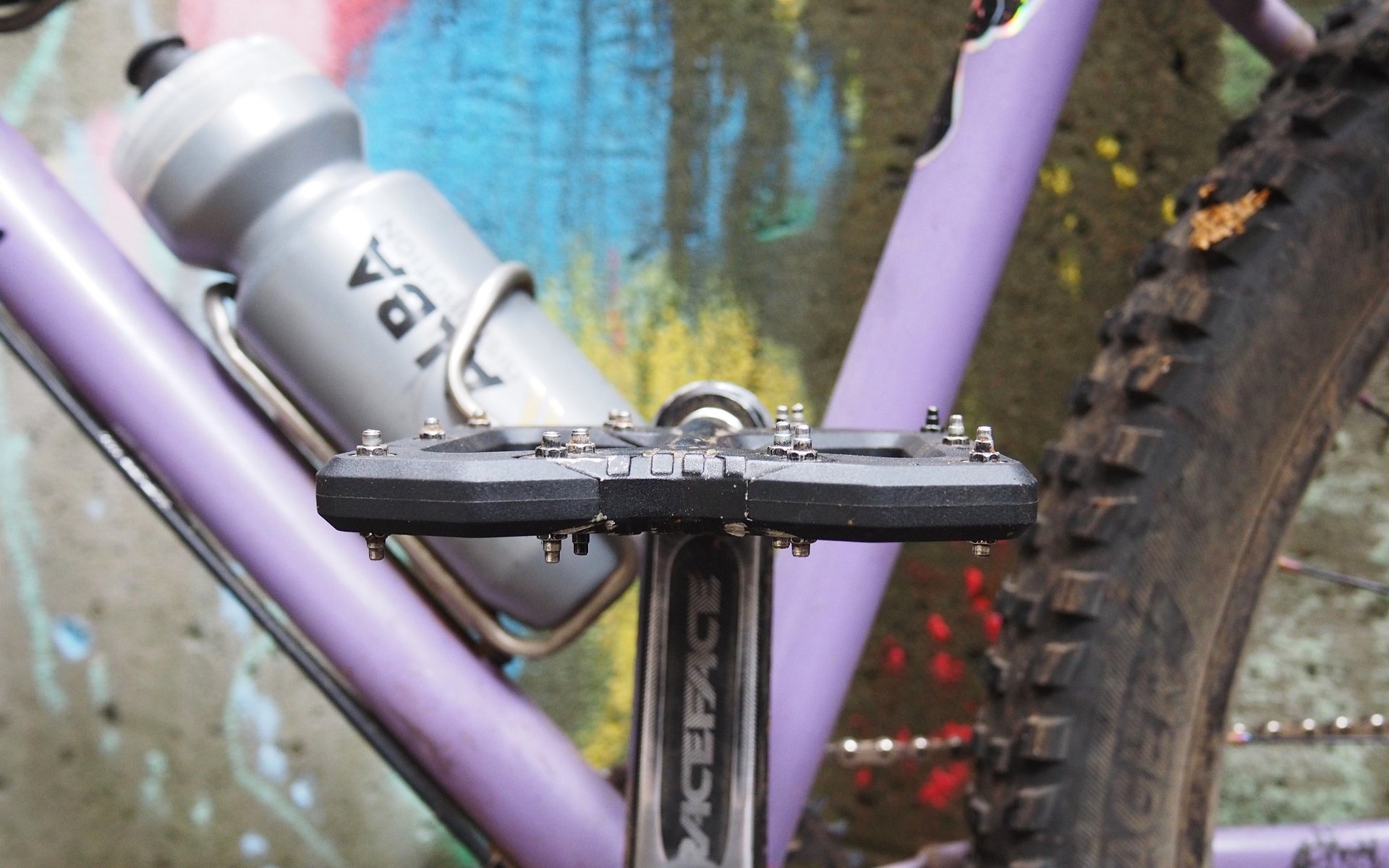
EDITORIAL
Asymmetric Plane Flat Pedals: A Followup
Quotables
Of all the pieces I've written for NSMB, the comment section in Flat Pedals, Foot Position & Reach was one of the most enjoyable. Inspired by Richard from Squidworx, I've had some interesting rides since then, and wanted to address a few points.
First, a couple quotes from smart people:
- "To set the record straight, personal preference is reason enough to defend your favorite width. I'm not going to dictate which bar you should ride." - Richard Cunningham (used in Handlebar Width And Staying Gracious)
- "If you are a pro, you ride the fastest thing you can get. If you aren’t, then you can ride anything that suits you.” – Keith Bontrager (used in You Should Ride A Rigid Fork)
In other words: What works for you works for you. Keep an open mind, try different things, think about why you like your bike setup the way you like it. At the end of the day if you have bigger feet than Michael Jordan and after trying a bunch of stuff you're running the smallest concave pedals on the market with an arch-over-axle foot position and that works for you then that's rad.
That said, it's possible to draw a couple of generalizations when it comes to flat pedal profiles and foot position:
- Riders who prefer a ball-over-axle position generally prefer a pedal shape like the classic DMR Vault with its 17mm of concavity.
- Riders with an arch-over-axle position generally prefer a convex or plane (flat-flat) pedal.
- And folks with big feet and thick Five Tens seem to like the Chromag Dagga no matter where their foot sits.
Many readers have gone on to borrow different sizes and shapes of flat pedals from their friends in order to challenge their own preferences. Whether they end up changing their setup or reinforcing their existing preference, this is a free opportunity to maximize their experience through testing touch points.
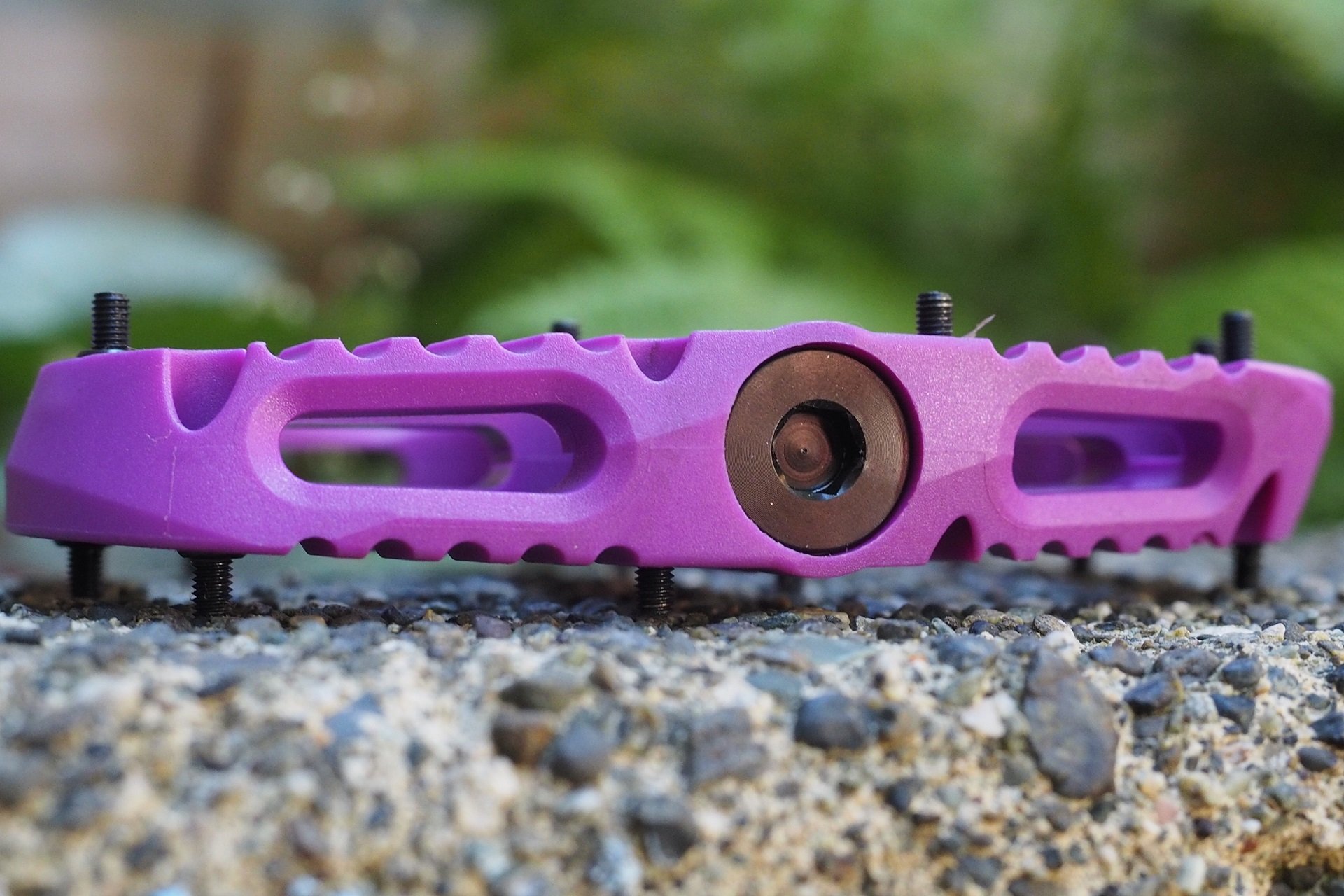
Convex pedal body.
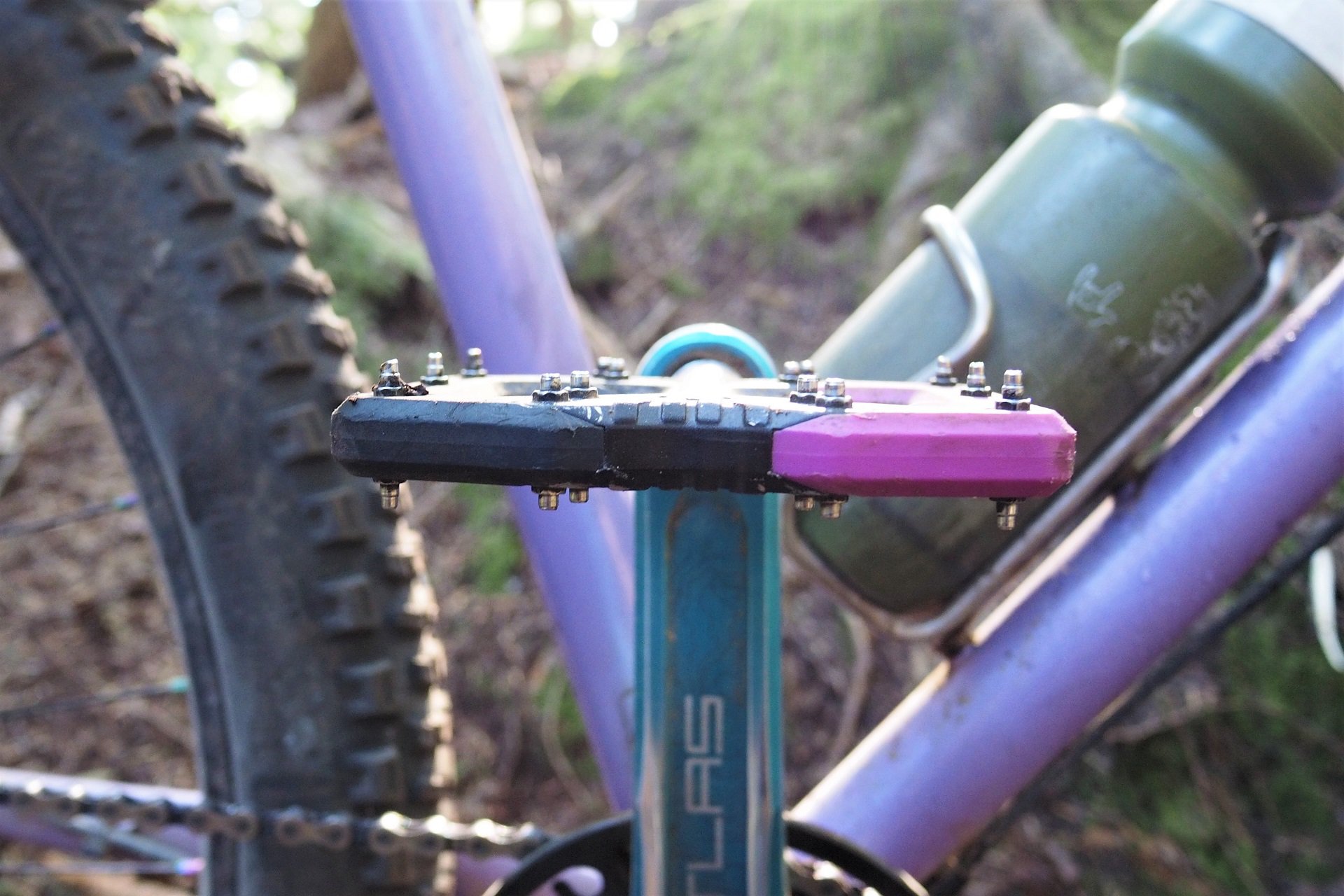
Plane pedal body.
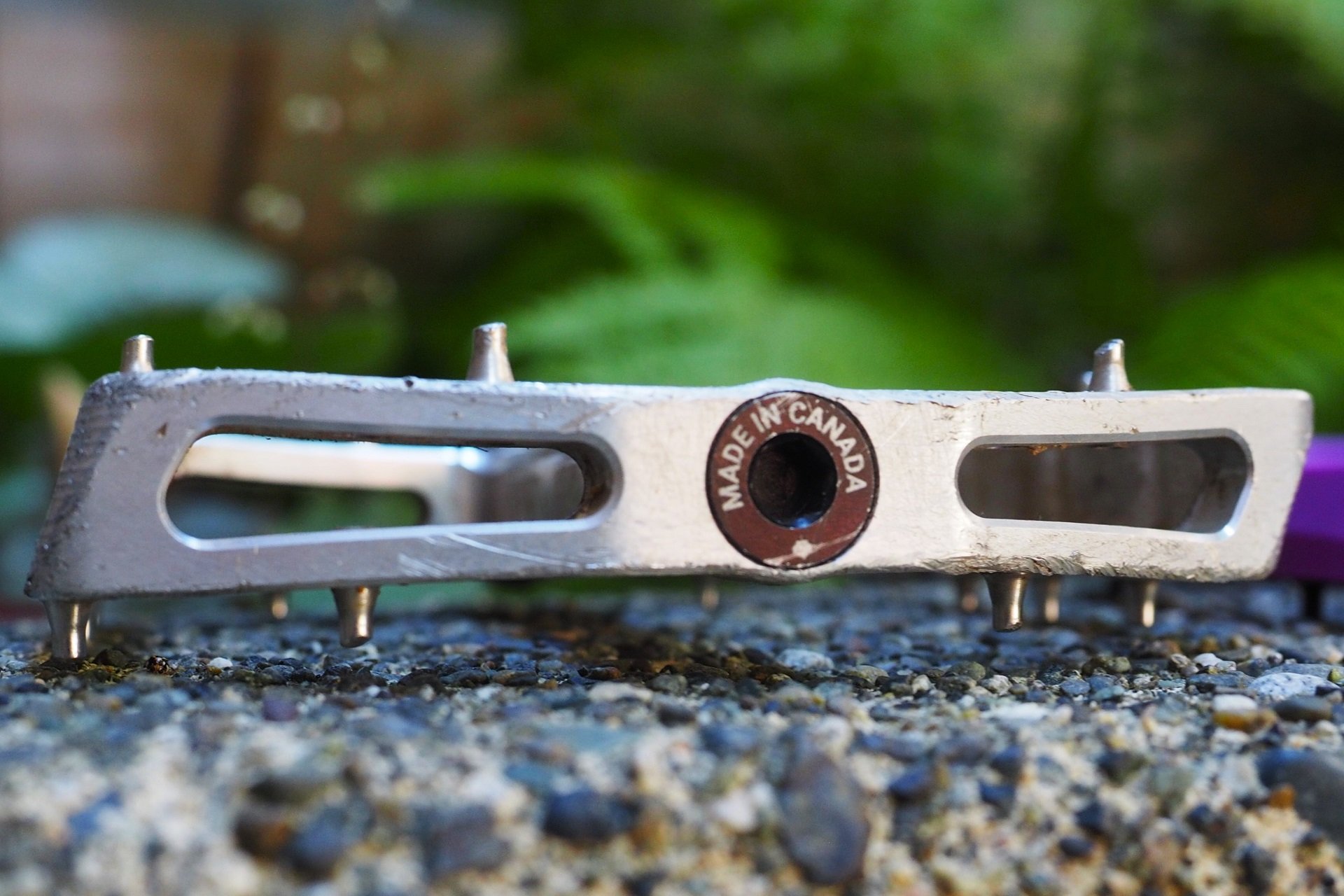
Concave pedal body.
Plane Pedals
If you're a rider who isn't sure where you want your foot to sit, what pedal profile should you choose? Two clear options come to mind. If you come from a clip-in pedal background, as I did, then you can't go wrong with a concave profile like the DMR Vault or Chromag Scarab. Even if you run your cleats all the way back in your shoes, it's likely your feet will naturally gravitate to a ball-of-foot over axle position.
But if you don't know, or want to keep your options open and let your feet find their happy spot, then a plane profile (as in flat-flat) pedal could be just the ticket. Bear in mind that, confusingly, some pedals in this category are plane, but derive some concavity from their pin profile, like the Crankbrothers Stamp 3.
I discovered a new appreciation for the Stamp 3 since my foot position changed after my ankle injury. Instead of finding myself between sizes, the large's 114mm x 111mm platform is now perfect for my current arch-over-axle position and I've noticed improved grip as well. I should perhaps change the concluding paragraph in my Wah Wah 2 review as I'm now very happy these pedals are flat rather than concave.
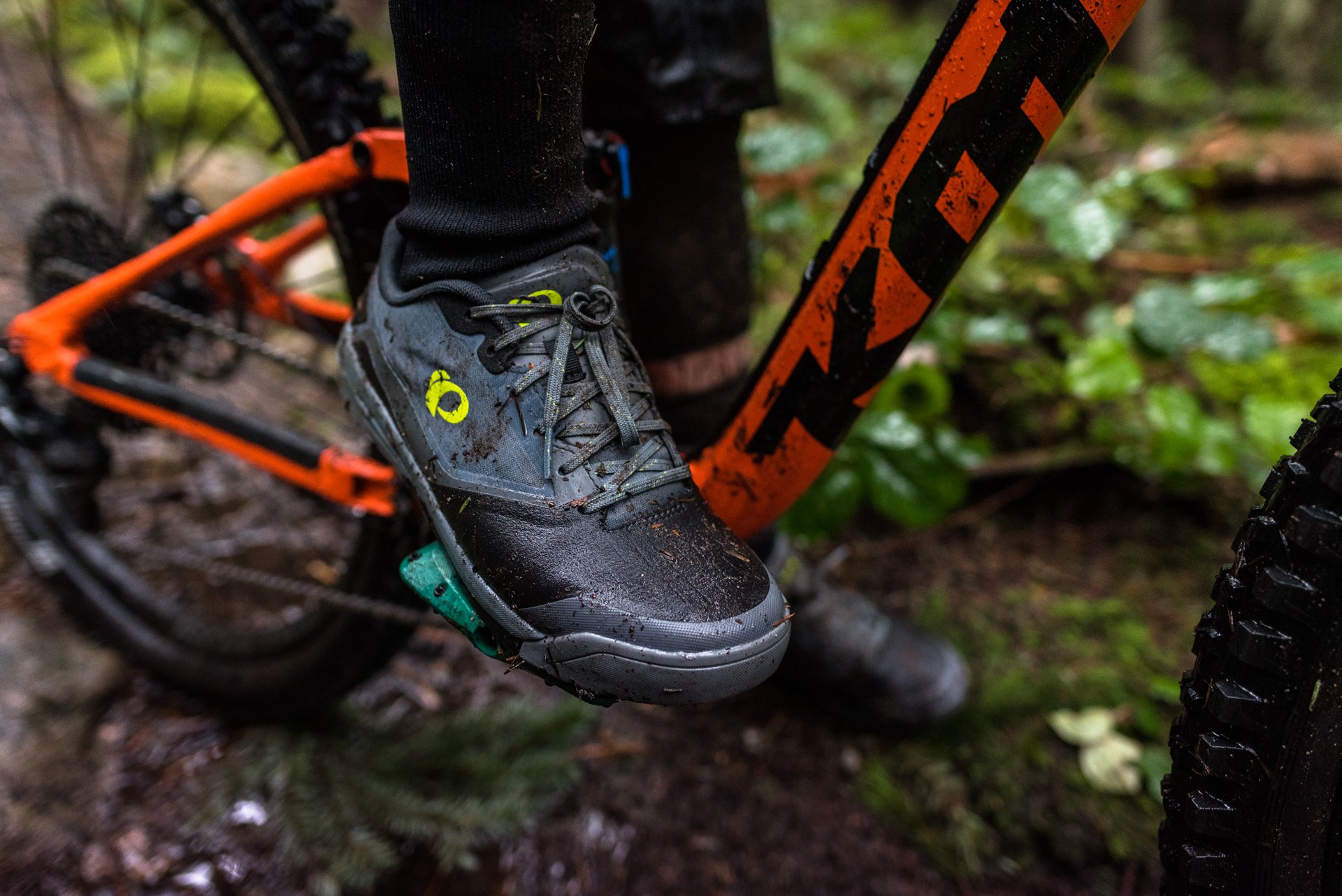
When I reviewed the Kona Wah Wah 2 I was a ball-over-axle pedaler and concluded the review wishing the pedal had some concavity. Having recently spent time on the same body, I'd now say the shape is perfect but could do with a couple more pins. Photo: Dave Smith
Asymmetrical Setups
"Very interesting! Maybe there's a place for wavy pedals: convex behind the axle and concave in the front. :D" - Martn
Right as I finished laughing about Martn's "wavy pedals" comment, I ended up talking to Richard at Squidworx pedals. As with my Crankbrothers experience, my medium sizing preference from the Squidworx review was called into question. The beauty of Squidworx's modular design is that it only costs 5 CAD per plastic cage (or 20 CAD for a set of pedals) to change sizes. In my case that meant jumping from a 97mm wide x 108mm long body to the larger 105mm x 116mm body. That might not sound like a huge change but it made a big difference in terms of how stiff my shoe-pedal interface feels underfoot.
Where this became really interesting to me is pin position. I had been running the plane Squidworx pedals with a concave pin setup - 5.5mm pins on the outside and 4mm pins in the middle - and intended to switch this to a convex setup (4mm pins on the outside and 5.5mm pins in the center) to see how that compared in terms of arch-over-axle landmarking. Richard offered a very different suggestion. He has a very obvious front-foot preference when descending, and in the development of these pedals he found that running longer pins on the rear of his trailing foot's pedal resulted in substantially fewer pedal slips.
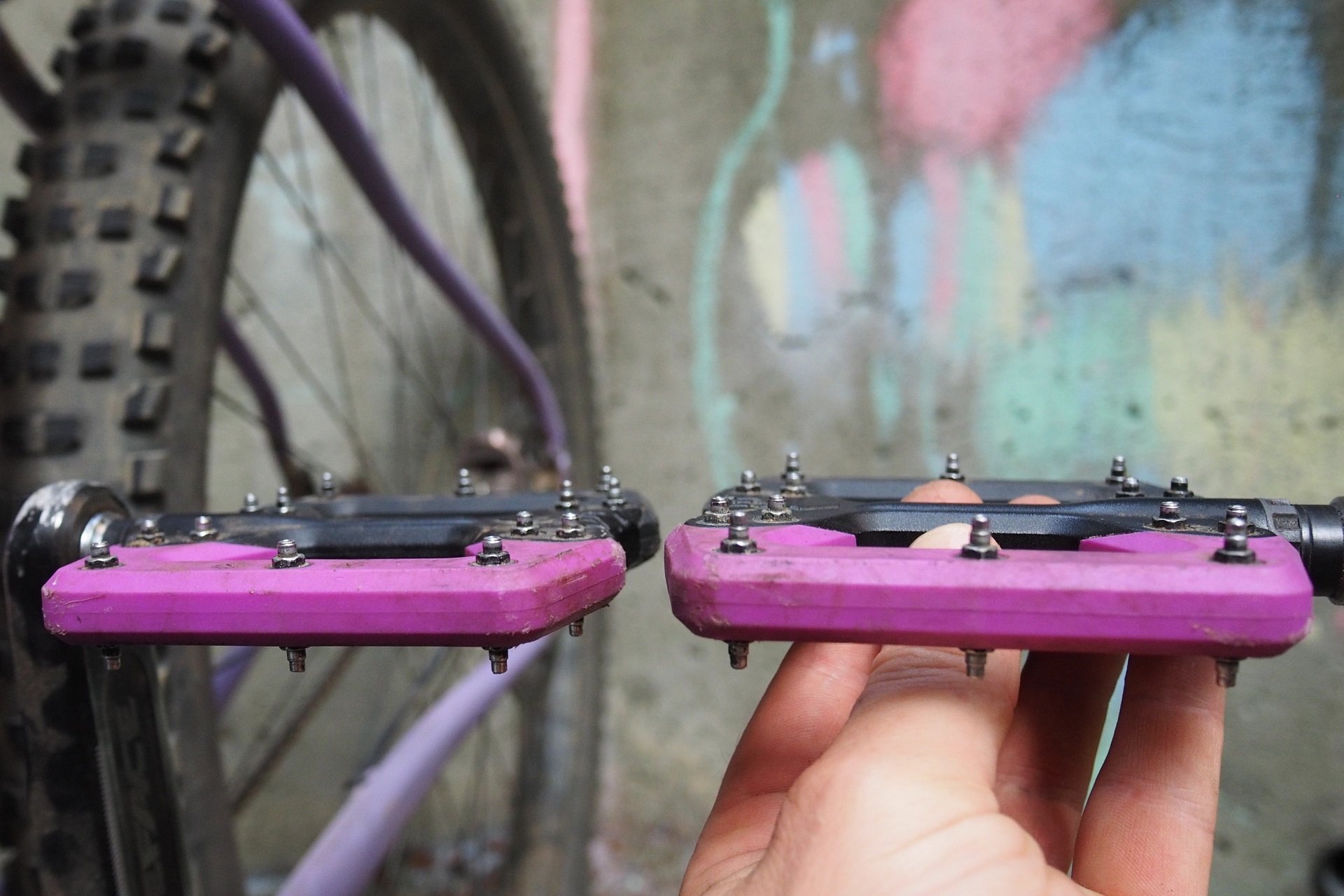
Could you handle an asymmetrical pin setup on your right and left pedals? I don't see an issue but I'm also okay with mismatched front and rear tire brands.
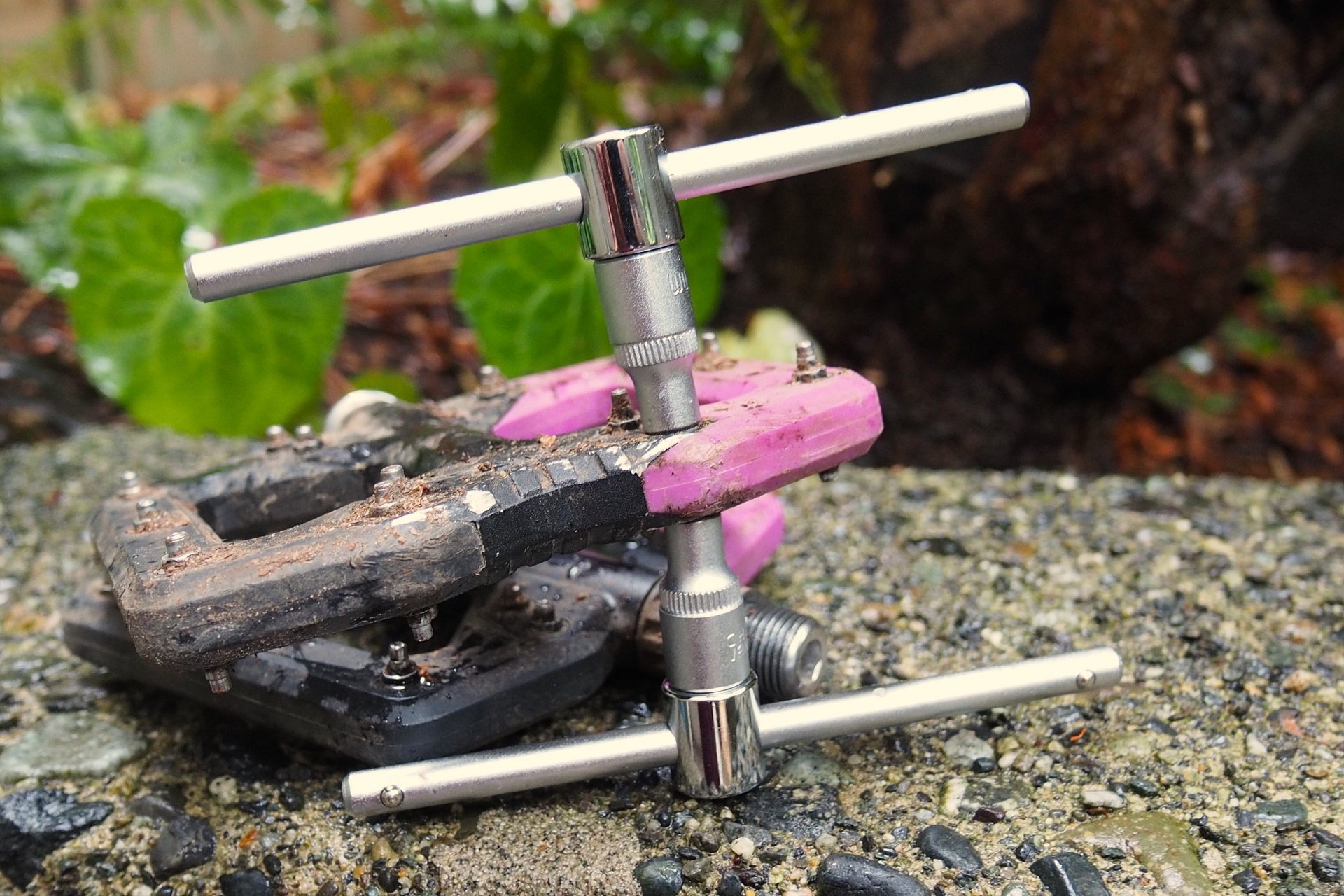
For an apples-to-apples comparison, I first swapped pins on the familiar medium-sized pedals for a couple of rides.
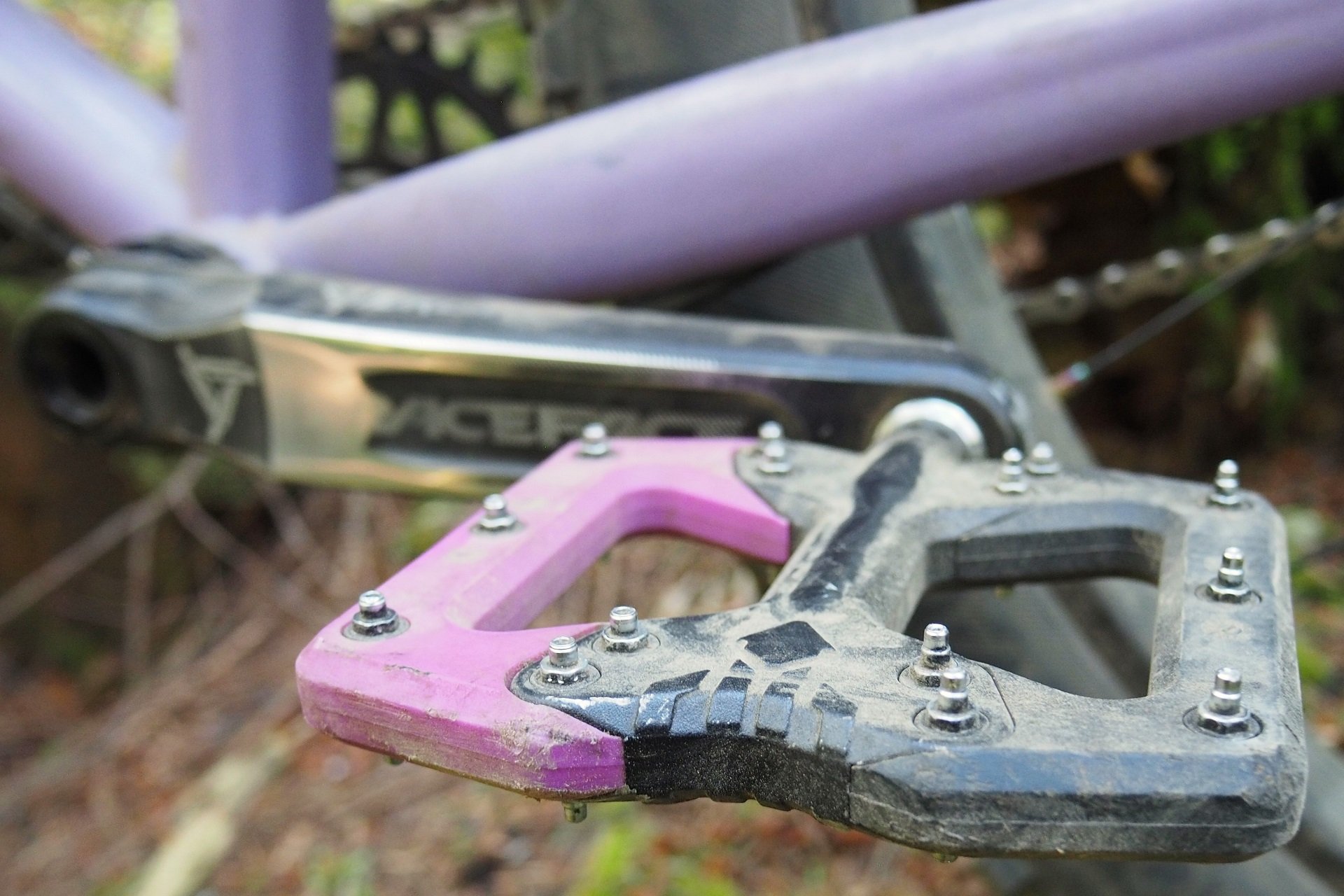
My left foot is my trailing pedal. Note the 5.5mm pins at the rear and 4mm pins at the front. The pedal is set up this way on both sides (purple is rear when flipped).
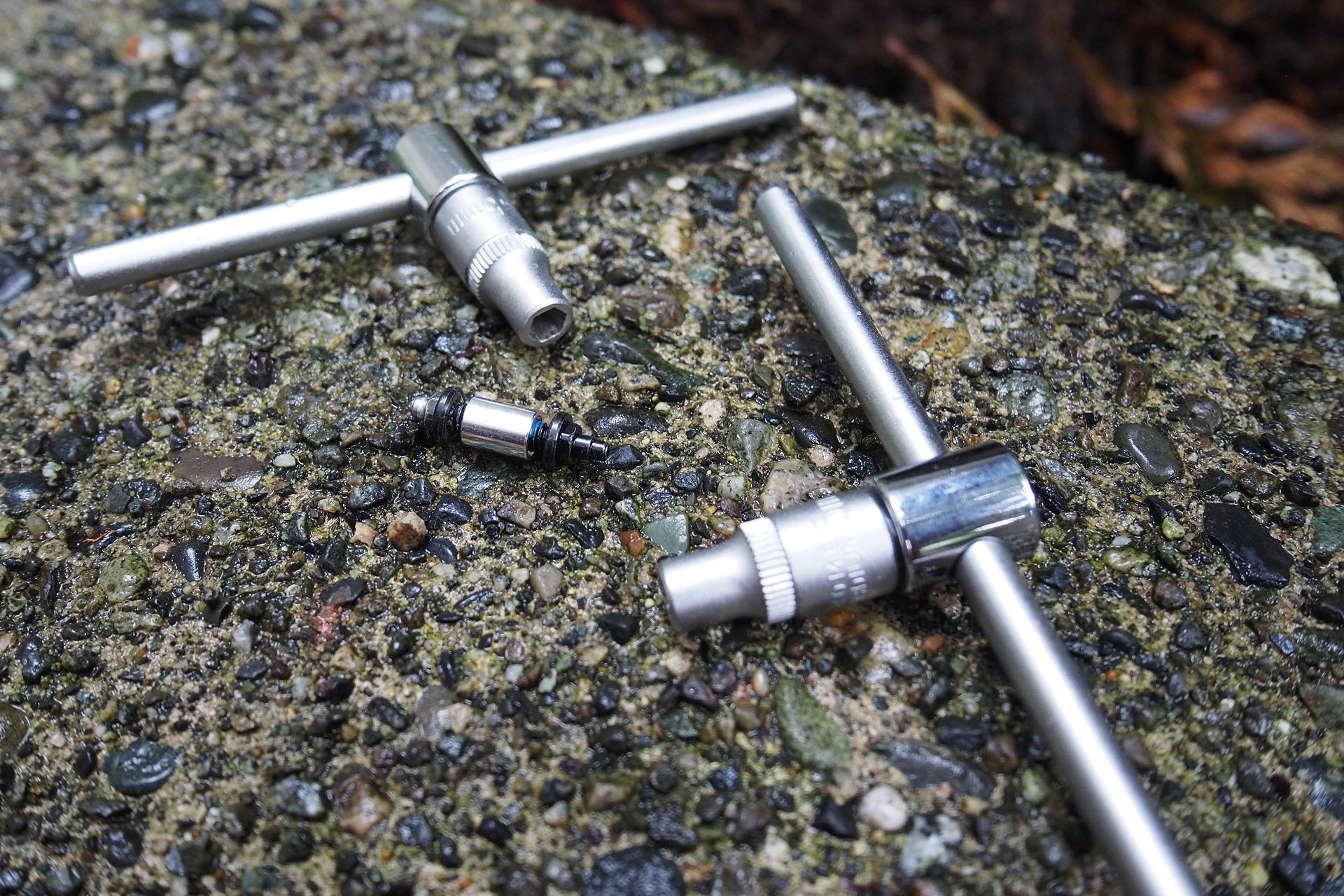
The stainless steel Squidworx pins thread from both sides into a center barrel that's easily replaceable. The pins are 75 cents each and available in black or silver. Barrels cost 95 cents each.
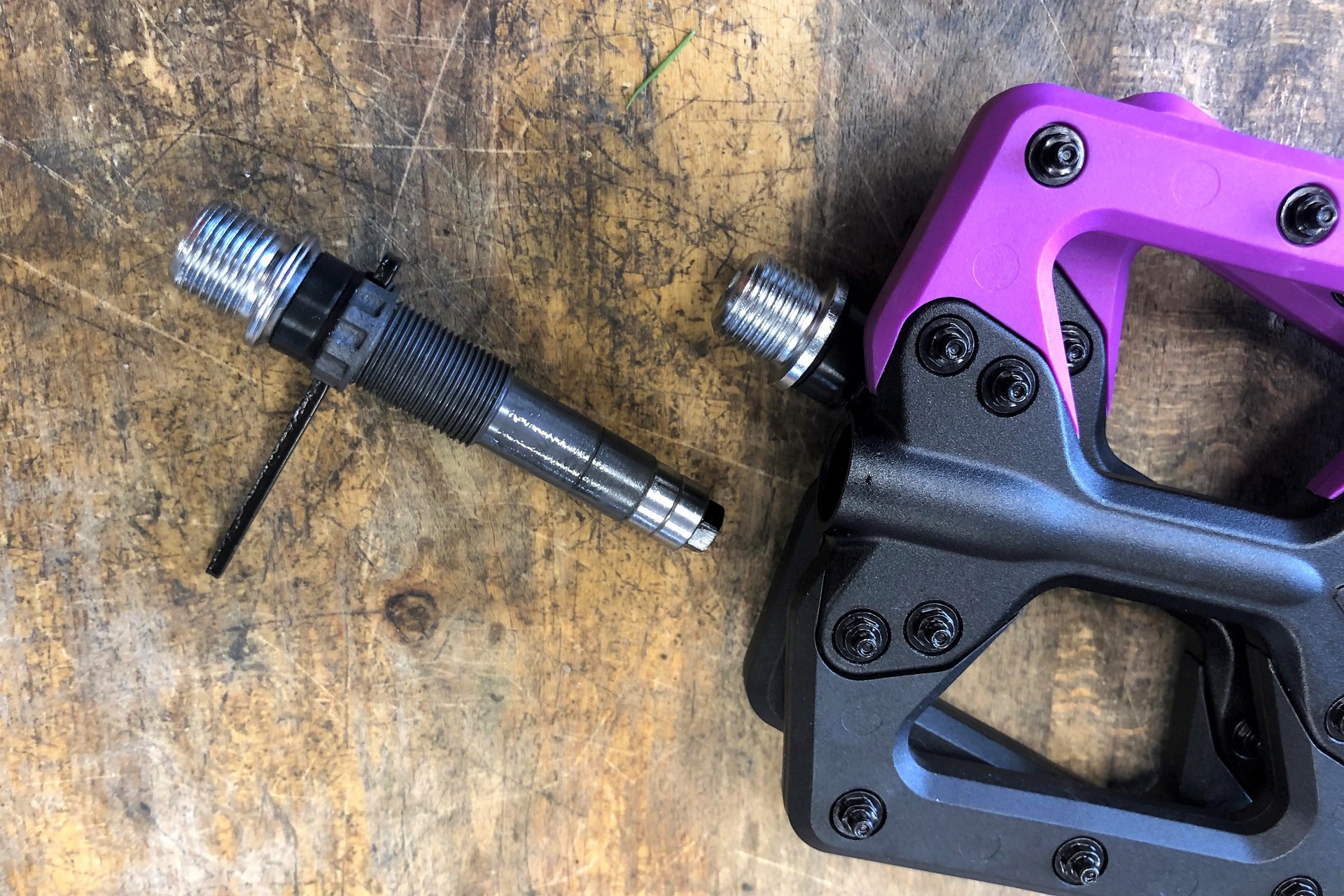
The self-extracting axle system is sweet and easily serviceable. The little extractor wrench is included. The internals are 20 CAD for both sides or 35 CAD including new axles.
With parts in hand, all it took was a little time and a pair of 5mm sockets to try Richard's setup for myself. I left my right pedal as I'd been running it and only swapped the pins on the left, trailing foot, to start. For the second ride I swapped the right side to a convex pin position with the taller pins in the center as that's how I intended to run the pedals using the larger 'wing' options.
I'm not going to say that everyone should run out and adjust their plane pedals so their trailing foot has taller pins at the back. But damn, it actually works very well in terms of keeping my foot in place as I'm bouncing my hardtail down janky terrain. It worked so well that I'm also planning to adjust the pin heights on my Crankbrothers pedals to determine if this is a Squidworx-specific experience or something more universal.
As far as I could glean, none of the holdout pros racing DH or EWS on flat pedals are running an asymmetric pin setup, and I can appreciate how that influences folks' pedal and shoe decisions. I can also only comment on how this pin setup is working with a mid-foot, arch-over-axle position. Regardless of what the most dynamic flat pedal foot position may be, that's what's available to my legs right now, so that's how I'm pedaling. If you're also an arch-over-axle pedaler don't be too stressed about whether that's optimized or not; I have years and years of experience doing it the other way and this works great too.
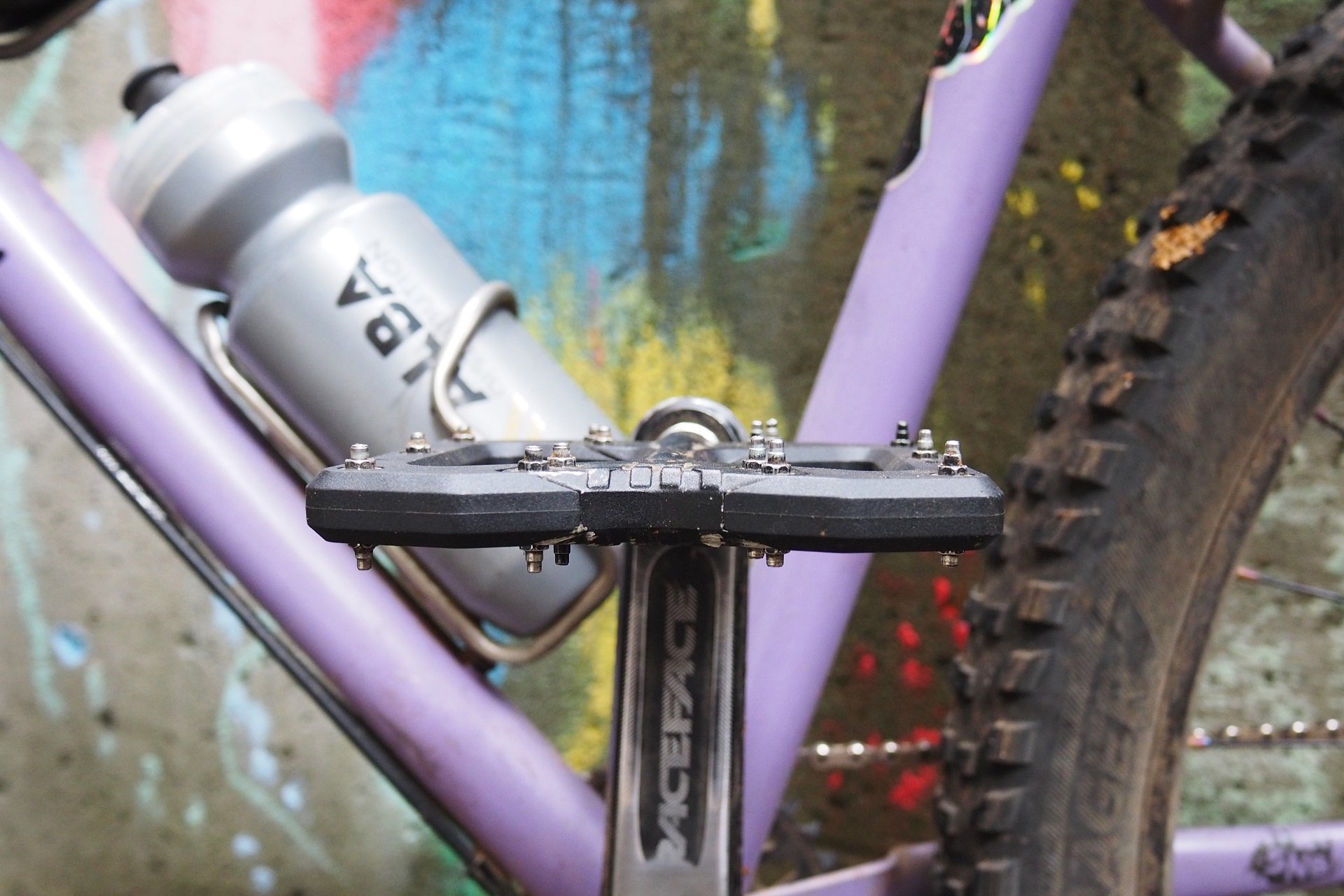
The non-drive pedal has Richard's asymmetric setup with the longer 5.5mm pins on the back half and shorter 4mm pins up front. I never would have arrived here on my own but after a couple rides I'm sold on the idea.
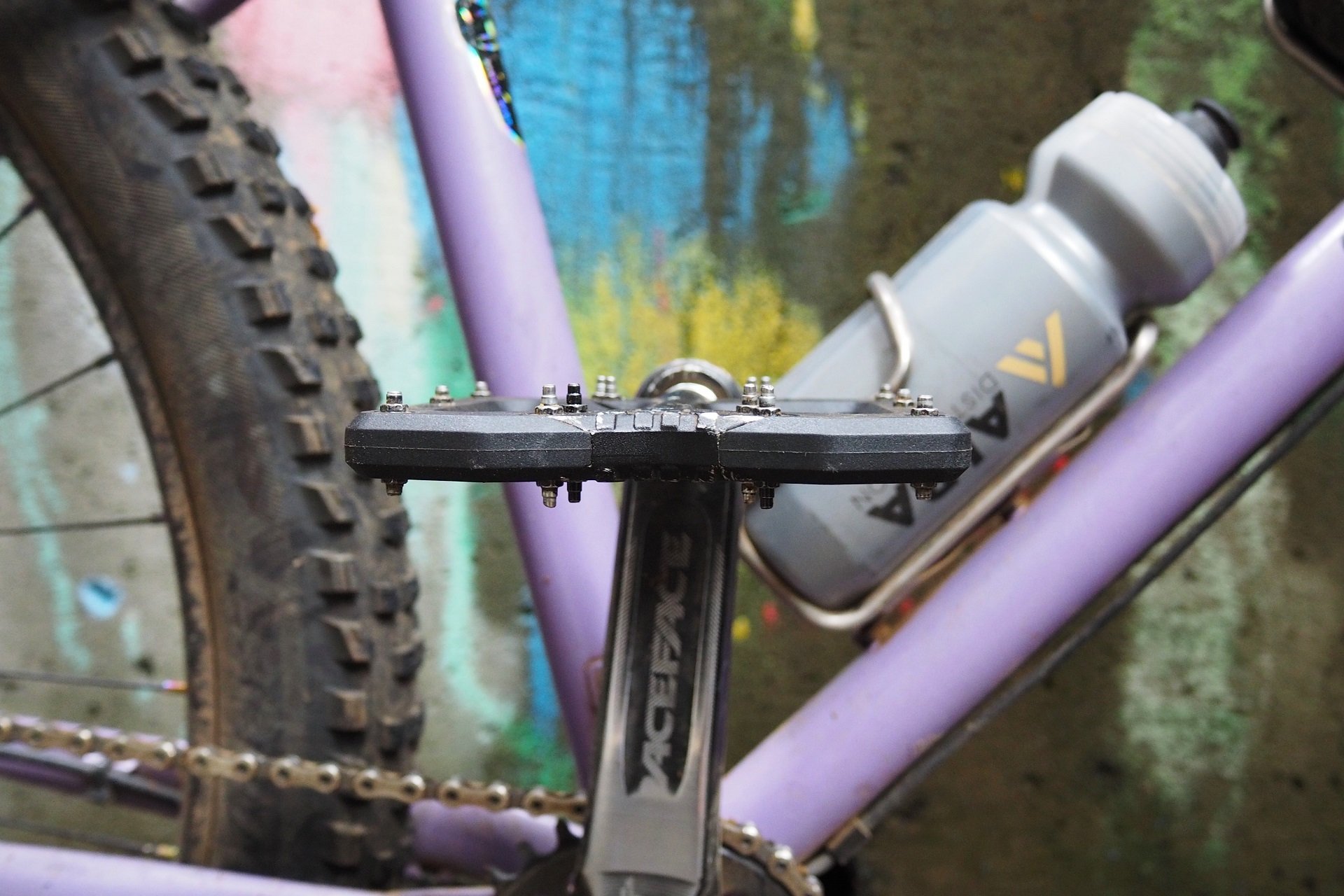
Drive side pedal has the same convex pin configuration as I ended up running with the medium cages. It's a plane body with 5.5mm pins in the center and 4mm pins fore and aft.

The difference between the medium 97x108mm and larger 105x116mm platforms is notable but it's conceivable that Squidworx could bring a larger option to market.
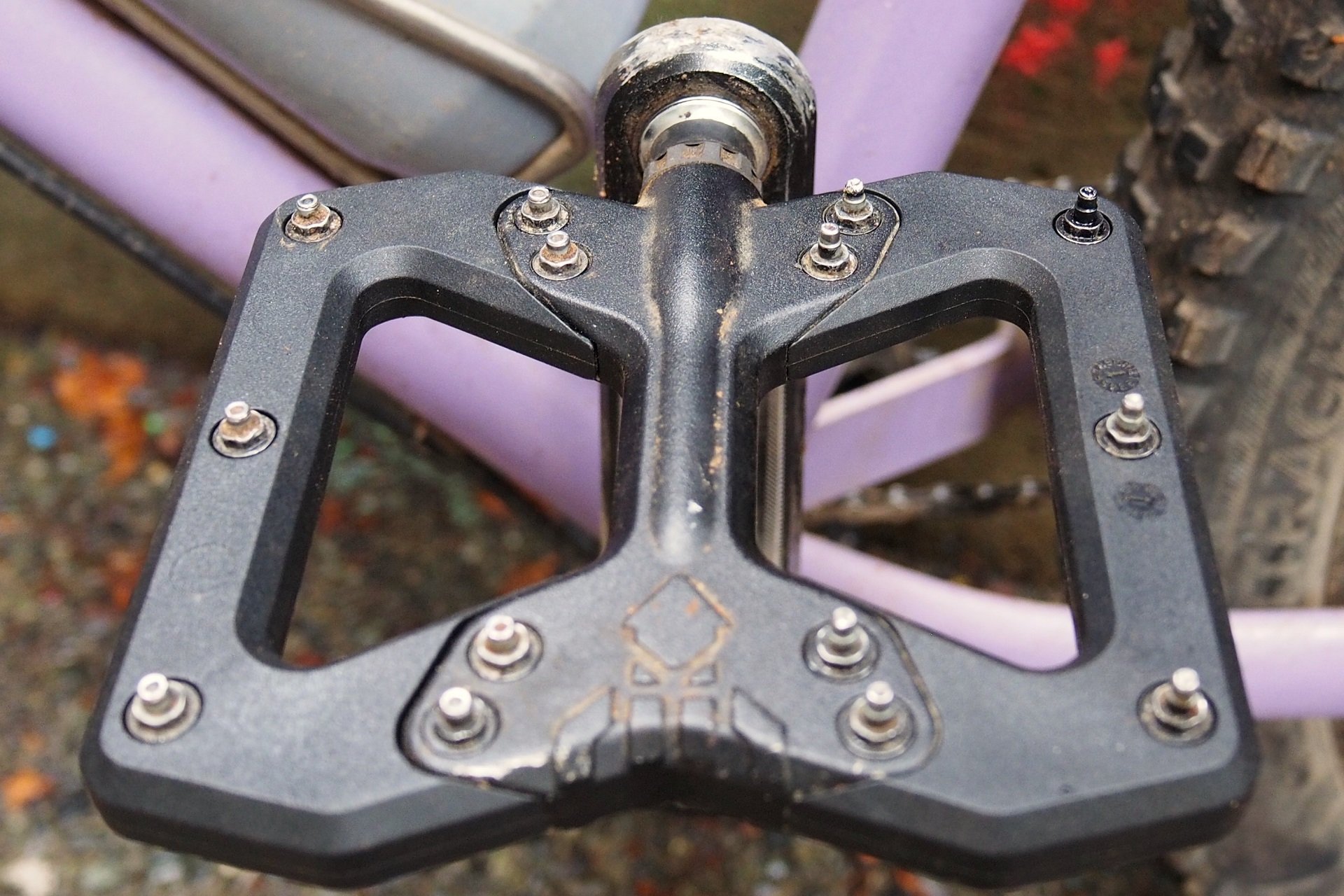
No, I haven't gone boring on you. The large and small cage inserts are currently only available in black whereas the medium cages come in twelve colours. The center sections are available in anodized black or silver.
If you're running plane pedal bodies with any kind of thru-pin - studs or screws that thread in from the back side - it's easy to add washers under the pin heads to experiment with different pin heights. The pins I have kicking around are all 0.8mm and came out of a OneUp pedal pin sets. Squidworx currently sells their pedals with flat, convex, and concave pin patterns - all with the same plane body setup. The 'Richard' option for those who want taller pins on the tail half of their trailing pedal is not currently on the menu. But it's neat that, after spending years refining and prototyping his unique pedal design, Richard was willing to put his own 'weird' pin setup out there.
This has me wondering how many other bike and component designers have unique setups that they'd never try to sell to customers but which works really well for them. Whether it's suspension setup, frame sizing, or tire size, it's great that there are folks experimenting away from the norm. I just wish more of them were willing or able to share the unique things that work for them.
Asymmetric plane pedals, a setup worth trying if you're curious.
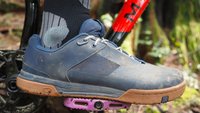
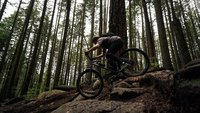
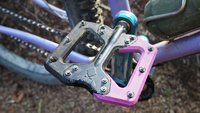
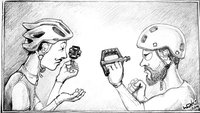







Comments
Friedel
1 year, 7 months ago
Can‘t say I‘m top happy obviously beeing a Stereotype now as I have a ball over axle foot position and used to ride Vaults beeing 90% happy. But I also have large feet and niw ride Impact Pros on a paar of Daggas and am 100% happy.
Boy did that section made me laugh!
Thanks Andrew
Reply
Andrew Major
1 year, 7 months ago
Hahahaha, sorry?!
Cheers!
Reply
DadStillRides
1 year, 7 months ago
A little tangent on the dmr vaults: definitely my favorite feeling pedal as well, but I broke 2 on my dj the first season they came out and didn't dare try mashing then on rocks with my full squish. Have other people had durability issues with the vaults? Or what I'm hoping to hear - durability issues in the early days, but something that's since been resolved?.. Would love to justify trying them out again.
Reply
Kent Tse
1 year, 6 months ago
I have had two pairs of Vaults with the first pair approaching a decade of riding. In terms of durability, I've smashed them into rocks and mangled the pedal threads to such an extent that new pins won't stay in. The current ones may have revised this but I haven't bothered getting newer ones since the main body is still in okay condition.
I got new bike last year with all new geo which means a low BB so I decided to look for pedals that could take the abuse of more rock strikes. After ~2600 km of riding I can conclude that DMR V11 is a good match for me. The composite body is very durable and there are no bends. That said I did manage to sheer a pin and an edge of the body on a really hard strike but for less than 40 Canadian Pesos to replace the pair, I can't complain. The same impact would definitely have bent the Vault.
Reply
papa44
1 year, 6 months ago
Arf i came to type word for word what you already have. Could cromag dagga pilots be anymore stereotypical?
Reply
Andrew Major
1 year, 6 months ago
Hahahaha. Thanks for this.
Reply
Cy Whitling
1 year, 7 months ago
Lord I love this maybe too-deep of a dive. And I have to agree. Once again, you've articulated phenomena that affects me but I haven't been able to quite figure out. I tear up the soles of my shoes on my trailing foot way, way faster than I wear out the soles of my leading foot. That trailing left foot is obviously doing more work to keep my body squared up on the bike. When I go through my pile of retired bike shoes, my left shoes are all chewed to crap, with wear through the rubber into the sole plate, whereas my right shoes are much less worn.
Reply
Andrew Major
1 year, 7 months ago
Interesting. When I get home I’ll pull my shoes out and have a look to see if there’s any trends between pairs.
Too-deep dive, indeed.
Reply
SomeBikeGuy
1 year, 7 months ago
While you're at it, compare your leading and trailing pedals. I'd be shocked if your trailing pedals weren't significantly more battle-worn than your leading pedals. Diving in even deeper, I'd put money on the trailing edge of your trailing pedal being a bit more beat up than the leading edge.
Reply
Cy Whitling
1 year, 7 months ago
Oh yeah, for sure, I replace pins on my trailing pedals at a ratio of 3:1 to those on my leading pedals. Although, for me, it's the bottom leading edge of the trailing pedal that gets chewed up.
Reply
Andrew Major
1 year, 7 months ago
I'm also trailing pins on my leading pedal. That's across three pairs that have been in regular use.
Reply
JVP
1 year, 7 months ago
That reminds me, I've got 3 very bent pins to saw off and replace on my trailing/left pedal. I keep forgetting this until I'm on the trail and my foot is bouncing around. Doing it tonight.
Reply
Michael Klein
1 year, 7 months ago
I tend to beat up the trailing edge of my leading pedal, but bang my toes on the trailing foot. Maybe I'm riding with my feet in a wedge (leading heel down, trailing heel up) like Kyle Warner would tell you to, without having noticed 'till now.
Reply
Lynx .
1 year, 7 months ago
Hahaha, wondered how long it would take for a follow up :-) Another good one ;-)
Well, I'll step straight to the Monkey on your back there Andrew with the asym pin setup and ask....so what about when you need your other foot forward cornering or as lots of great instructors would tell you, to try and balance and use both feet forward? Neat idea for sure, but straight up those were my 2 thoughts on it.
Expect that this section will be very shortly filled with too many comments to read.
BTW, did you ever get a chance to measure up your collection of pedals for me?
Reply
Andrew Major
1 year, 7 months ago
So riding janky technical trails there are always going to be times when your off-foot-forward and I do even practice this on easier trails.
It hasn’t been an issue (nor has it been climbing at all). The pedals still have solid grip and I certainly ride much more cautiously off-footed anyway. Where asymmetric pins have potential is when I’m ‘charging’ down stuff which only happens for me right foot forward.
Reply
AndrewR
1 year, 7 months ago
Except when really pushing it the average (99.9%) human defaults to their strengths and thus will perform critical or crux moves with the common trailing foot trailing and the lead foot leading.
Coaching a rider in lead foot switching has its potential pit falls as riders tend to switch feet by back pedalling exactly when the bike least needs to be back pedalled. Different for an aggressive rider that is always putting a pedal stroke for extra speed but that kind of rider doesn't really need lead foot/ balanced riding coaching. Most great coaches would let that sleeping dog (lead foot switching other than for car park drills) lie.
This 'custom' pin configuration makes total sense when one considers how the trailing foot is used to maintain contact with the pedal and lift the bike.
Seems like a pfaff that can easily be avoided by riding clips!!
Reply
Pnwpedal
1 year, 7 months ago
I came from BMX and even though I've been on MTBs for 19yr some habits stuck around for way too long. One of those was riding on the ball on my foot. The rear edge of the pedal would wear a line in the shoe footbed, at the front of my arch, and cause pain. I just chalked it up to wearing out shoes. But after switching to a PNW composite pedal and moving my foot forwards on the pedal my feet and calves feel so much better on long rough descents. I kind of do a conscious dance of foot position changes, but our rides in SW WA and NW OR are mostly long climbs and long descents. So ball of foot for climbing, front part of arch for descending. So far it seems to be working.
Reply
bushtrucker
1 year, 7 months ago
Love the level of thought that's going into this Andrew. Time to order some DMR King Pins it seems!
Reply
Tjaard Breeuwer
1 year, 7 months ago
Interesting.
My issue is more about placing my foot on the pedal in the correct position every time. Riding a full suspension bike, I don’t really have issues with my feet bouncing off.
Reply
Vik Banerjee
1 year, 7 months ago
Without trying I've been buying Flat flats all these years. I don't really find foot placement an issue and I do use different foot positions on the pedals depending on what is going on. I don't find my feet bounce off the pedals with sharp pins and soles in reasonable condition with sticky rubber. The few times it happens it's about the same frequency on my hardtails as my sag wagons and I know either I need new pins or new shoes or both. In rough terrain I just ride the sag wagon faster or over poorer line choices until the thrashing is the same as the hardtail.
Reply
Andrew Major
1 year, 7 months ago
The problem of course being after I’ve ridden the sag wagon a few times in a row and I find myself flying into a rooted descent on my rigid rig and I ask myself “well, how did I get here?”
Reply
Velocipedestrian
1 year, 7 months ago
This is not my beautiful house, this is not my beautiful wife...
Reply
Andrew Major
1 year, 7 months ago
Thank you.
(But may I suggest, "This is not my beautiful truck... this is not my beautiful bike..." instead?)
Reply
fartymarty
1 year, 7 months ago
IMO one of the best albums ever made. That's going on my playlist for today.
Thanks for the excellent earworm.
Agleck7
1 year, 7 months ago
Never really thought about it but I’ve usually had different pin setups on each pedal on my flats.
Reply
Andrew Major
1 year, 7 months ago
As in something you’ve arranged on purpose or because you tend to shear them off on one pedal rather than the other?
If it’s the former I’d love to hear more about how you ended up there. I’d never considered it.
Reply
Agleck7
1 year, 7 months ago
On purpose. Usually it’s arranging them or adjusting height on the outside corners of the pedals as I always ride left foot forward so when i corner I torque the pedals in different ways on each foot. So I’ve tweaked them for better feel while cornering but not necessarily the same across different pedals (Vaults, deftraps, daggas) and honestly not sure what the pattern is.
Reply
Andrew Major
1 year, 7 months ago
Neat! Thanks. It’s cool that other riders have gone there - it’s not something that ever would have occurred to me.
Reply
albert03
1 year, 7 months ago
I've gone to OneUp composite flats on all my bikes for consistency (and lower cost). I hadn't thought of asymmetrical pin placement, but as I look at my shins and calves I see that I've got a lot more scars on my trailing leg. Hmm.
Reply
Andrew Major
1 year, 7 months ago
When I was talking about this piece with a friend he actually looked down at his shins and stood silently scratching his beard and nodding his head. His trailing foot was clearly more battle scared both fresh and long term.
I think Richard at SquidWorx is clearly on to something.
Reply
Martn
1 year, 7 months ago
Hah, so my not so serious comment actually led to something. Nice. I might try adjusting the pins myself. Can't do it on my Burgtecs but it should be possible with the Chromag Synths that I have as a backup. Until I get those back (left them on a bike I borrowed in another town after a rather unpleasant incident with a tree) I will pay some attention to the differences in foot angles and maybe applied pressure.
Reply
Andrew Major
1 year, 7 months ago
Hahahaha. I talked to Richard at SquidWorx the same day and was still chuckling hours later. Crazy how something that was funny one minute became a bit of an obsession the next.
Reply
Martn
1 year, 7 months ago
Silly banter is way too underrated. I bet lots of great tech started as a joke.
Reply
Andrew Major
1 year, 7 months ago
No doubt at all!
That, or ripped off from old Star Trek episodes…
Reply
Martn
1 year, 7 months ago
Like all the kids riding around with small Tricorders strapped to their handlebars? :D
Reply
fartymarty
1 year, 7 months ago
Martn - if you're on Burgtec metals you can buy different length grub screws. If you're composites it maybe a problem altho washers may do the trick.
Reply
Martn
1 year, 7 months ago
Thanks for the suggestions. I'm on the aluminium version. Have you tried regular grub screws on those? The ones Burgtec uses are special in that they have the (tiny) hex interface inside the pedal body, accessed through a small hole on the other side. The actual thread is larger than what sticks out.
It should be easier to try the Chromags first. If I remember correctly, they even included some washers.
Reply
fartymarty
1 year, 7 months ago
I've got the aluminium MK5 and have use M4x12 Dog Point https://www.accu.co.uk/dog-point-set-screws/5173-SSD-M4-12-A2 and have also tried M4x14 Dog Points which are a bit long.
I've also got MK4s which use a M5.
Reply
JT
1 year, 7 months ago
Guess I'm a bit of an odd man out here as my forward foot shows 99% of pedal strikes. Over the years I've made a practice of alternating which foot is forward in all riding conditions. In my spouse's words, if you can only spin one way, it's a trick. If you can spin both ways it's a skill. Still a bit (lot) awkward on jumps, but it's proven a valuable skillset when riding behind locals at mach chicken on unfamiliar trails where you don't know where the turns/jumps/drops are and only have a split to correct position for them. May give a go on setting both pedals up asym for a learning experience. Old dawgs can be taught new tricks yet.
Reply
bushtrucker
1 year, 7 months ago
Would the pedal strikes come more from the forward foot being the foot you first do a downward stroke with when approaching an obstacle? I'm a right foot forward rider and rarely strike my left foot either.
Reply
Andrew Major
1 year, 7 months ago
With my pedals as evidence, my forward foot is taking significantly more or harder hits.
Reply
Jimothy.benson
1 year, 7 months ago
I'm naturally left foot forward, but have been making a conscious effort over the past several years to ride "inside foot forward". There's a whole 'nother rabbit hole to go down there about half-pedal strokes, being comfortable when caught unprepared going off something, etc.
Given my "inside foot forward" preference though, I do wonder whether I'd be more likely to shear off the taller rear pins given that they will be the leading edge most likely to meet rocks half the time. Anyone with any experience there?
For context, I'm riding composite Kona Wawas on 5.10 freeriders (size 42) on a singlespeed Honzo ST
Reply
fartymarty
1 year, 7 months ago
Andrew - do you ever see yourself going back to clips?
As a serial swapper i'm always going back and forth between both (always clips on the "road bike" though). I'm currently back on clips and enjoy the lack of thinking associated with clips. Maybe that will change as things get wet and slippery.
Reply
Andrew Major
1 year, 7 months ago
No? Maybe…
I even commute on flats but I’ve thought for longer rides on the road/gravel I may like to get that float back. I’ve hung on to shoes and like re-stanced Eggbeaters so clearly it’s not a never thing.
But since I made the switch and put the effort into getting half-way decent at riding flats I’ll certainly say they’re more fun, which for me is the whole point. Even if there’s the odd technical climb I don’t make (especially on the #1FG) or it adds a bit of time on the climbs.
Reply
Agleck7
1 year, 7 months ago
What are re-stanced eggbeaters?
Reply
Andrew Major
1 year, 7 months ago
I need more q-factor than the Eggbeater pedals provide so I run them with the axles out of Mallet DH pedals.
I wrote about it if you’re interested.
Reply
Agleck7
1 year, 7 months ago
Thanks!
Reply
fartymarty
1 year, 7 months ago
It would be interesting to see hear your thoughts once back on clips given you've been a long time on flats.
Reply
Andrew Major
1 year, 7 months ago
A couple years, but I rode flats a bit over my couple decades of predominantly clipping in so I feel I can talk about the advantages of either system.
The biggest change has been my mentality. I used to REALLY care about making every steep punch or technical move on my single-speed that my friends could make on their multi-speed bikes and now I don’t. So short of changing priorities I’m not sure what would motivate me to clip-in on the trail.
But who knows. If I get more serious about riding my gravel bike I’ll certainly put clips on just to play with it. First I need narrower rims/tires because my ATB build is comfortable but not quick.
Reply
fartymarty
1 year, 7 months ago
Good call on the change of mindset. For me clips make sense for road and to some extents gravel as you aren't riding technical terrain and don't need to be active with body / foot placement.
I read a comment from Ryan Leech in an older NSMB article (written by either Cam or Pete) about him changing from clips to flats and re-learning how to ride and eventually getting better on flats as a result.
I rode cliped in last night - first proper ride in a few months on a local trail I have been sessioning over a few rides. It's not overly steep but clayey, chalky, rooty and off camber in parts. I think the flats are going back on as it was quite slippery (I need to change tyres from Vigi to Verdict/Judge slippery) and flats would have given me a little more freedom to get off the pedals and dab.
Reply
Pete Roggeman
1 year, 7 months ago
Always good to revisit Ryan Leech's flat pedal course. I'm coming out of a flats only phase that lasted about mine months and am now a 50/50 split depending on the ride (and to an extent, the bike). Two weeks ago I ride a very steep, dusty trail with some exposure and would have preferred to be on flats, but c'est LA vie. One or two sections ended up being a bit dicier due to tough stop/start moments and getting clipped in in time, but overall it was a good reminder of why I like to stay fluent in both platforms.
Raymond Epstein
1 year, 7 months ago
"The biggest change has been my mentality. I used to REALLY care about making every steep punch or technical move on my single-speed that my friends could make on their multi-speed bikes and now I don’t. So short of changing priorities I’m not sure what would motivate me to clip-in on the trail."
This. The only tinniest of motivation for me to return to flats would be to pull through technical punchy climbs that I have more trouble riding flats on. However that has opened a whole new window of challenges that I have to work on. These for a descending fan primarily have been oddly satisfying when I nail them. I speak of clearing 1.5-2'+(0.6m) root/rocks across an already steep incline midway through a technical climb. All of this has been aboard my hardtail as I wait to build up a new full suspension bike. That I could nail and be completely comfortable down janky descents on flats with that bike has also been enlightening.
Reply
Martn
1 year, 7 months ago
Hm, the short and punchy climbs are the main reason I left the clips on my singlespeed. Plus it seemed too much work to stay on the pedals with a fully rigid bike (that's a pun intended for all the german readers) opposed to a hardtail. Maybe it's time to give it another try as I'm much more at home on flats by now and the short, punchy climbs … well I think I don't care as much anymore. I might even ride it more often. I have found myself put off by the clips a little bit in the last two years or so.
Reply
Andrew Major
1 year, 7 months ago
It’s crazy how many things I can make it up now on the rigid 1x1 with flats that i couldn’t imagine doing when I first made the switch. Even with my leading leg still very underpowered.
At the same time, yes, it’s all about your mindset. If you need to make every climb then clip in.
Now if anything I miss clips more on my FS bike. It goes faster downhill and I find I still bounce a foot off sometimes (more often than on my hardtail).
Reply
Pete Roggeman
1 year, 7 months ago
Came here to say I caught the pun - nice one.
Reply
Martn
1 year, 7 months ago
Cheers!
Reply
Lynx .
1 year, 7 months ago
As another who's been "forced" into riding flats like Andrew because of injury. I like them OK, but I have been a clipless rider since the first year I started riding and so, I lack proper technique and miss the ease at finding foot placement and staying connected to the bike they bring. That being said, since going to flats full time, I have found that I need/prefer a wider Q-factor than most clipless pedals allow for, so, for right now I won't be going back any time soon - also because not even close to back to good with the knee.
Reply
Andrew Major
1 year, 7 months ago
Just to clarify, I started riding flats exclusively for a short time about four years ago do to an injury, but switched back to clipping in the majority of the time after I recovered.
The main influence on my switching to flats full time was riding with my daughter.
Reply
fartymarty
1 year, 7 months ago
Got ya. When i'm riding with the kids it's flats all the way.
Reply
Andrew Major
1 year, 7 months ago
That was the motivation initially to ride flats more and then when I started getting halfway decent at it, it started just being more fun on janky trails versus the fact that I'm not in a hurry (which is where I could still see using clip-in pedals).
Reply
taprider
1 year, 7 months ago
I place my feet between arch over and ball over spindle, so do I need a concave front 1/2 half and convex rear 1/2 of the pedal?
Reply
Pnwpedal
1 year, 7 months ago
Perfectly flat seems to fit that bill, at least for me.
Reply
tmoore
1 year, 7 months ago
It gets complicated, you also need to consider if it's your leading or trailing side and whether you're heels down or not on that foot.
Or just get some Dunlop Purofort boots and any pedal with good pins will work well. The boots have big, soft lugs and raised heels. Put the heel of the boot against the back of the pedal, get your trailing heel down and you're good to go. Bonus that they're waterproof and are steel toed, they offer excellent shin protection and have surprising ankle support.
Reply
taprider
1 year, 7 months ago
work boots are already a "thing"
https://bikepacking.com/news/alexandera-houchin-2019-tour-divide/
Reply
tmoore
1 year, 7 months ago
They sure do the trick for Alexandera!
I have Dunlops for wet days and Helly Hansen boots for dry days. The most novel thing about them for mountain biking is the raised heel. I put the front edge of the heel against the back edge of the pedal and get a ton of extra security.
Reply
taprider
1 year, 7 months ago
anyone patented an "S" shaped pedal yet?
Reply
Andy Eunson
1 year, 7 months ago
I found this the other day and although it’s all about road and triathlon set up, I think it’s also quite applicable to mountain bike flat and clipped in set ups. The only real negative of feet further forward on the pedals is fast sudden acceleration which we don’t do as often off road. If I do place my foot arch over the spindle on flats, it doesn’t feel as positive descending I think because I lose the suspension effect of ankle flex. I have size 40 feet so I have less suspension effect than a rider with longer feet. https://youtu.be/t7oGuel--Lc
I checked my shoes after your previous article and I have my cleats as far back on the shoe as they can be. That’s why I think on flats my feet gravitate to about the same place.
It is my back foot on flats that tends to lose it now and again. I’m learning to "wedge" my back foot more these days. It is starting to work better. I’m going to experiment with longer trailing pins too.
Reply
Pete Roggeman
1 year, 7 months ago
Interesting. Many (most?) people would disagree about a foot forward position not having any disadvantages. Especially when descending, having the arch of your foot over the spindle and dropping your heels gives you more control and a better ability to handle rough sections at speed. The ankle flex you mention does make sense until you're going fast enough or over rough enough terrain that it becomes a liability and leads to pain for some. Are you on a dually or hardtail? Is your terrain rough?
Reply
Andy Eunson
1 year, 7 months ago
Both hardtail and dual. I live in Whistler so similar to North shore.
Reply
Lynx .
1 year, 7 months ago
I found the opposite for me when I finally moved from the power efficient ball over spindle to spindle just behind ball, it let me "balance" much better on the pedals, which translated to much more confidence and ability t move/rotate my foot in the tech terrain, whereas with spindle under ball, I always felt pitched forward onto my toes and had a few good OTBs in slow tech terrain because of that.
"Interesting. Many (most?) people would disagree about a foot forward position not having any disadvantages. Especially when descending, having the arch of your foot over the spindle and dropping your heels gives you more control and a better ability to handle rough sections at speed. The ankle flex you mention does make sense until you're going fast enough or over rough enough terrain that it becomes a liability and leads to pain for some. Are you on a dually or hardtail? Is your terrain rough?"
Reply
taprider
1 year, 7 months ago
for unicycling, I found that my foot position was constantly changing (might have been applicable for singlespeed too?)
when I needed to spin faster, I would slide more onto my toes
Reply
John Keiffer
1 year, 7 months ago
Wonder what using both medium and large cages together would do to the foot and pedal mechanics.
Reply
Andrew Major
1 year, 7 months ago
The beauty of asymmetric pins is the pedal shape is the same and, as noted in my photos, it's easy to keep the contact patch the same no matter which side is up.
The problem with a medium + large pedal is that when it's flipped over it's a large + medium pedal. It's a bit like one-sided roadie clip-in pedals. It would work until you totally need to slam in under pressure and then they're never in the right position.
Reply
John Keiffer
1 year, 7 months ago
Thanks for the reply. I kinda thought it was a dumb idea after I posted it. However, pin placement is very interesting.
Reply
Velocipedestrian
1 year, 7 months ago
Except the Large side would outweigh the Medium? So the Medium should always be pointing up when you go to put a foot on it. Like the reverse of toe clips.
Reply
Michael Klein
1 year, 7 months ago
I haven't thought of this before, but I have a couple of riding buddies who ride a little knock-kneed, but only with the one leg. This results in them using only the outside half of the pedal on that side. Perhaps they would benefit from having a wider pedal on that side. Sadly it's the right leg for both, so they won't be able to split a pair of pedals.
Reply
neilBar
1 year, 6 months ago
Hi Andrew
Very interesting article you’re a thoughtful guy
Your Achilles injury probably has similar symptoms to my nerve damage (disc herniation damages sciatic nerve and limits calf functionality). So we both have a weak foot - mine falls into max dorsiflexion too easily. Impacts crush the front of my ankle joint.
I too am adapting standing forward on the pedals - now I am at last back in the bike (18 months off). I’ve found James Wilson’s Catalyst pedals aid that. I added DMR Moto pins to help me stay on the pedals too. My go to favourite is the Kona WahWah composite
Maybe something that’s helped me would benefit you too.
Dynamic tape
Working with the inventor, I’ve got a good Achilles supportive strategy (expanding on the video below) that’s allowing me to ride rough tracks without pain in the talus area (crease at front of ankle) on impacts
I can’t ride without - even standing to pedal is not really possible - with I’m fine
Don’t dismiss Dynamic tape as similar to any other tape you might have experienced. It’s properties are very different to kinesiology tape for example.
If your interested, I have some links to videos on application - a couple made by the inventor just for me. They expand on the generic one below
Here’s an example
https://www.youtube.com/watch?v=Wmo4bzOBVx4
If you’d prefer PM me and I’ll send you a set of links.
Neil
Reply
Andrew Major
1 year, 6 months ago
Hi Neil,
I'm getting a lot of support from the size large Squidworx platform while still getting a bit of shoe wrap. I do appreciate they work for the folks who've suggested them but the system is not for me, at least as it currently exists.
Interesting about the tape. I'm now wearing compression socks to help with swelling, and an insole for support as I always do, but in terms of support, at this point, it's all me. I like the feedback and can stand on a pedal down some fairly janky trails without discomfort.
Thanks for the suggestion though. Tape may have helped when I first was back on the bike and I was experiencing pain or discomfort constantly.
Cheers,
Reply
neilBar
1 year, 6 months ago
Ps. Andrew.
Did you mean to write that the vault has 17mm of concavity? Maybe a typo!
Even 7 would be a lot. I’m pretty sure it’s 17mm on the widest edge.
Reply
Andrew Major
1 year, 6 months ago
I assume it’s total concavity (both sides added together) but either way that’s what DMR lists on their website.
I don’t own a pair to measure and we did think about just changing it to ‘very concave’ but sometimes it’s fun to leave an Easter egg in and see if anyone mentions it.
Reply
Andrew Major
1 year, 6 months ago
Reply
neilBar
1 year, 6 months ago
This comment has been removed.
neilBar
1 year, 6 months ago
Hey Andrew,
There's no denying the Vault is an amazingly good pedal.
(especially, as you wrote, for ball of foot pedallers)
Right, I see where your info came from -
I suspect that where the website
https://www.dmrbikes.com/Catalogue/Pedals/Vault-2/Vault-NEW
states "17mm concave foot bed", that what it actually means that the Vault is a 17mm thick pedal,
(a 17mm footbed) which is also concave.
It's easy to mis-interpret the way its written - Going by the alloy Vault in my hand, "17mm Concave", as written above in your screenshot,
would be clearer if it was written "17mm, Concave", or even better "17mm and Concave".
My aluminium Vaults (over 5 years old now and working well) measure about 16.5mm at the edge,14.5mm in the middle.
So, by my measurements, it's 2mm of (body) conacvity per side - enhanced, of course by the pin height.
Easter egg ;~}
Reply
Please log in to leave a comment.